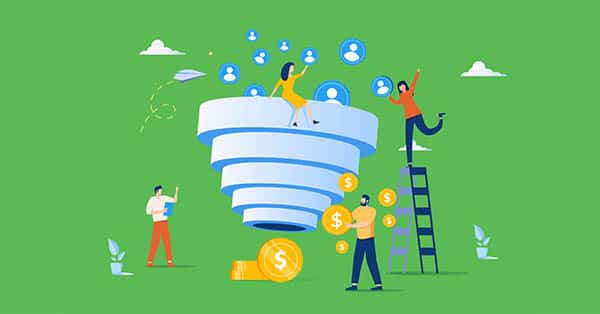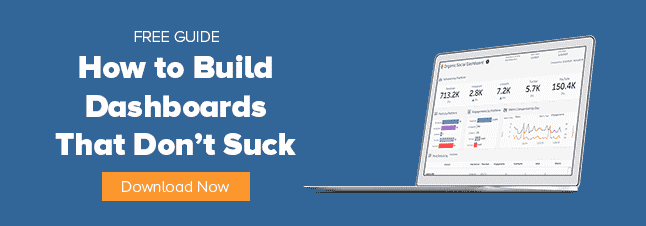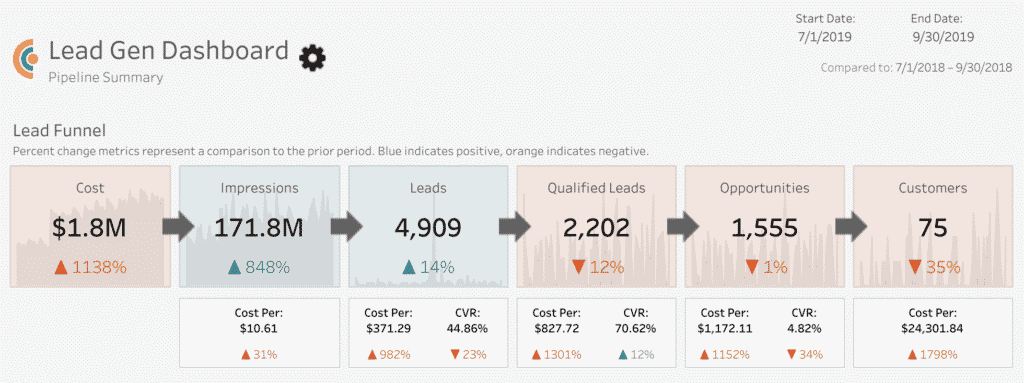
One big reason why aligning Sales and Marketing is so freaking hard?
Each team lives in its own little world. Or more accurately, its own little funnel.
Marketing has a marketing funnel, Sales has a sales funnel. But what you really need is a holistic lead funnel, one that shows Marketing’s impact and that tracks Sales performance in a single view.
A holistic funnel lets Sales and Marketing quickly identify sticking points and work together to fix them. Because ultimately, Sales and Marketing have to work together in order to succeed.
So, what does a holistic lead funnel look like? Here’s an example from one of our dashboards:
Now, your holistic funnel might look completely different. You might need to include different stages to reflect what’s important to your organization.
To help marketers choose the right stages for their holistic funnel, we like to play a game called Pick 6. (Not that Pick 6. Or that one.)
Pick 6 for Better Marketing and Sales Alignment
Of the following 10 stages, choose six to include in your holistic funnel.

On the marketing side, there are five options:
- Cost: How much you spent on marketing, advertising and promotions.
- Awareness: How many impressions you generated with your ads and marketing messages.
- Engagement: How many clicks, website sessions and other interactions were created as a result of your efforts.
- Marketing Leads: How many people have completed a form on your site, attended your event or completed some other activity indicating interest in your product or service.
- Marketing Qualified Leads: Of your leads, how many fit the demographic profile of one of your typical customers. Or, if you use lead scoring, how many leads hit the numerical threshold to be considered a qualified lead.
Sales funnels tend to be unique to each organization, but generally include:
- Sales Generated Leads: How many leads were generated by Sales as a result of their outreach.
- Sales Qualified Leads: How many leads have the budget, need, buying authority and timeline to purchase a solution like yours.
- Opportunity Phase 1: How many leads are a good fit for one of your solution offerings and, because of that, represent a solid opportunity to become a customer.
- Opportunity Phase 2: How many leads have advanced beyond a basic opportunity to a more advanced stage by completing a trial, bringing in senior leadership for a demo or some other signal of commitment.
- New Customers: While this one is self-explanatory, it’s also the most important of all your KPIs. And it’s one that your leadership is going to be most interested in.
Your Lead Funnel Might Look Different
So, of those 10 choices, which six are most important for you to regularly track? It all depends.
Let’s say you’re a smaller company with a one-person Marketing department. You only use a couple of marketing channels, like Google Ads and HubSpot, and your Sales team does most of the work of vetting leads. In that case, you might prioritize:

- Cost
- Leads, in the form of form conversions on your landing pages
- Sales Qualified Leads, because your Sales team is more responsible for qualifying leads
- Opportunity Phase 1
- Opportunity Phase 2
- Customers
This framework makes sense for an organization where more of the burden is falling on Sales.
But maybe you sell a niche product with a higher price tag and a longer sales cycle. You might focus on:
- Cost
- Engagement, because the typical buyer spends a lot of time looking at the content on your site before making contact
- Marketing Qualified Leads and Sales Qualified Leads, because you want to weed out weak leads early so you can devote more energy to the ones with the most potential
- Opportunities
- New Customers
Want Better Alignment? You Need to Do This Exercise!
Can you have a lead funnel with more than six stages? Of course. But I like six because you aren’t trying to track too many things — if you try to measure everything, you usually end up measuring nothing. And with six stages, there’s still enough variance between stages for you to see changes in sales volume and deal velocity.
You need to do this exercise. And invite your colleagues from Sales to join you. Gasp! Blasphemy! Yeah, sorry, you are going to have to talk to Sales. They’re going to have important insights, and this report should be a resource for them, too.
So get a whiteboard and list the stages that make sense for your organization. Use them to build a dashboard that helps you get aligned, forecast performance and drive real growth for your business.
Get the Insight You Need to Maximize ROI and Drive Growth
Alight’s Lead Generation Analytics solution combines an award-winning platform with analytics experts, enabling you to generate powerful insights and reporting for your entire funnel. Schedule a free solution consultation with our team!


